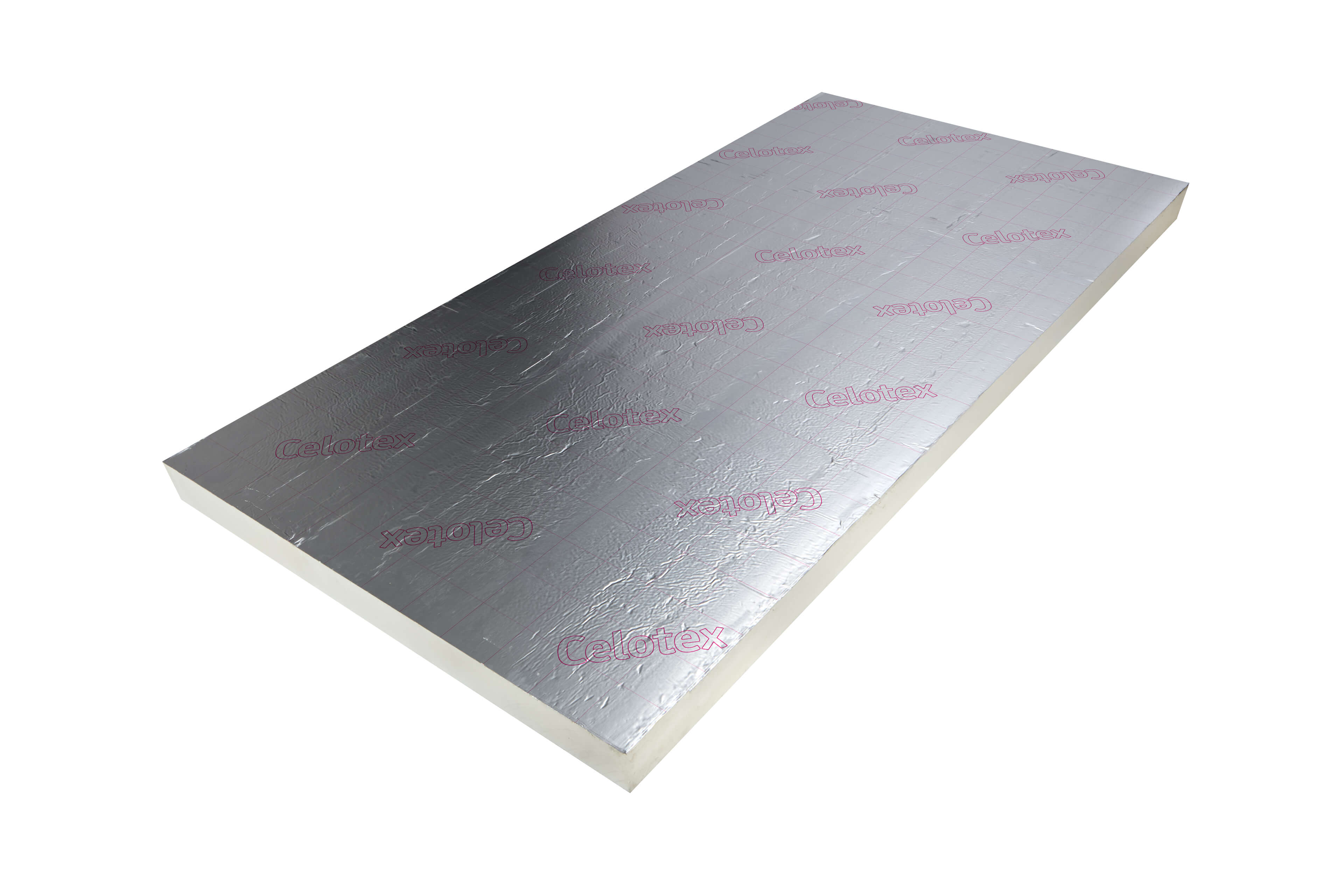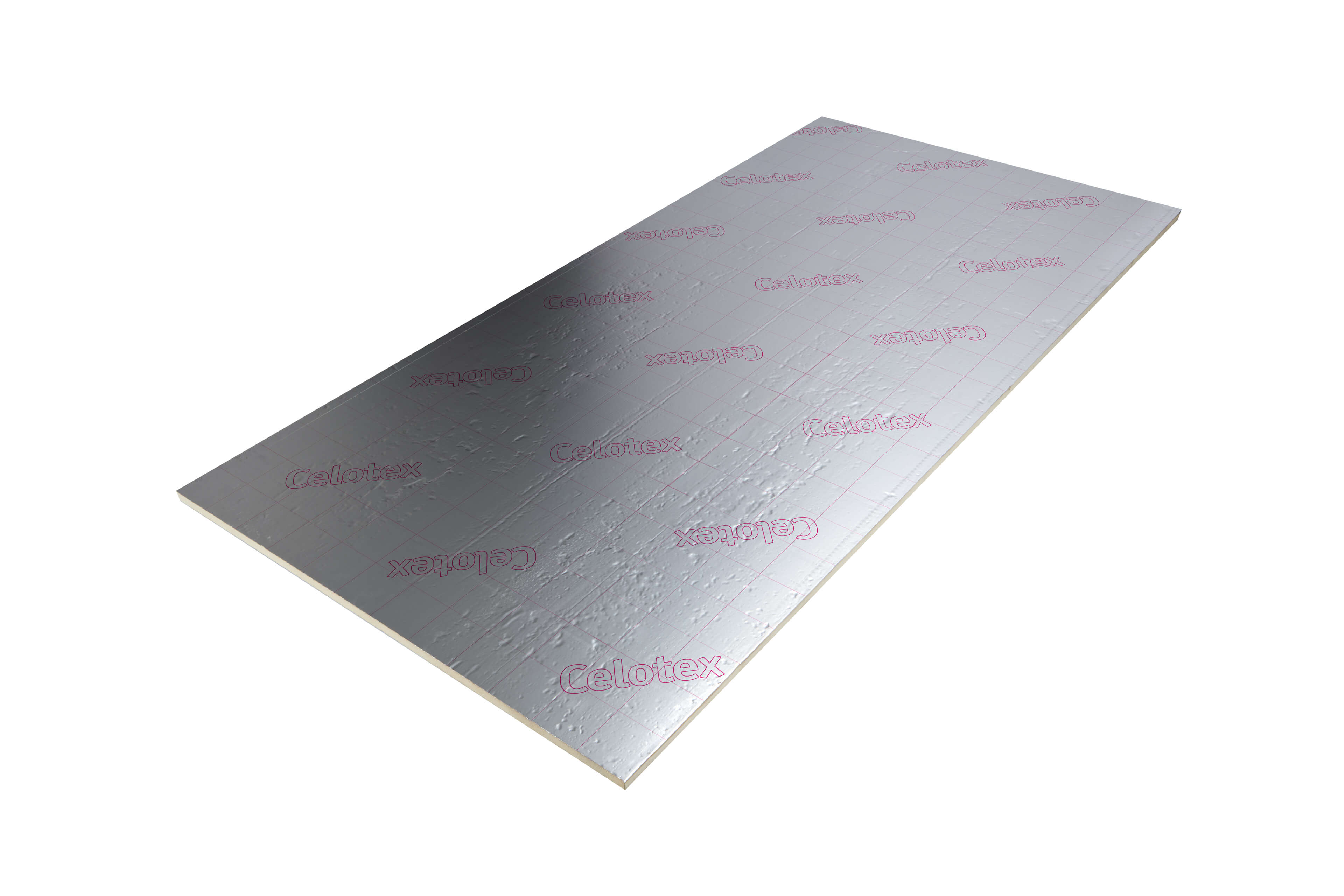Celotex Insulation Board
(24 Products)Celotex insulation boards are engineered to meet the varied demands of modern construction, offering tailored solutions for wall insulation, floor insulation, roof insulation, and cavity wall insulation. The hallmark of Celotex insulation is its unique combination of thermal efficiency, environmental sustainability, and ease of installation. Manufactured from polyisocyanurate (PIR), a closed-cell foam material, these boards feature one of the lowest thermal conductivity ratings available at 0.022 W/mK. This endows them with exceptional thermal resistance, helping buildings retain heat in winter and stay cooler in summer, which ultimately reduces energy consumption and lowers heating and cooling costs.
Understanding Celotex Insulation
Celotex is a leading UK manufacturer of PIR (polyisocyanurate) insulation boards, providing high-performance thermal solutions for roofs, walls, and floors. A subsidiary of the Saint-Gobain Group, Celotex specialises in rigid insulation products designed to improve energy efficiency in residential, commercial, and industrial buildings.
In an era where energy regulations are tightening and sustainability targets are becoming non-negotiable, Celotex insulation boards provide a solution that is both high-performance and future-proof. Designed for maximum thermal resistance with minimal thickness, these polyisocyanurate (PIR) boards offer an exceptional thermal conductivity rating of 0.022 W/mK, enabling architects and builders to achieve stringent U-value targets without compromising space or structural integrity.
By incorporating Celotex products into your project, you future-proof your building against rising energy costs, evolving sustainability standards, and increasingly stringent building regulations.
Benefits
- Moisture Resistance: Helps prevent the growth of mould and mildew, ensuring long-term performance in areas exposed to moisture.
- Sustainable and Eco-friendly: Low Global Warming Potential (GWP) and Zero Ozone Depleting Potential (ODP).
- A+ Green Rating: Achieves an A+ rating when compared to the BRE Green Guide 2008 - ideal for improving environmental performance and aiding in BREEAM assessments.
- Superior Thermal Performance: Low emissivity foil facings enhance the insulation's ability to reflect heat, improving thermal performance in cavity air spaces and reducing energy consumption.
- Lightweight & Easy to Handle: Lightweight nature simplifies cutting, handling, and installation, reducing labour costs and installation time.
- Versatility: Suitable for a wide range of applications, including walls, floors, and roofs, ensuring flexibility across different construction types and projects.
Sustainability
Celotex insulation boards are integral to achieving environmental and regulatory targets. Their zero Ozone Depletion Potential (ODP) and low Global Warming Potential (GWP) allow projects to exceed current building standards while making a measurable impact on reducing carbon footprints over a building's lifecycle.
Their inclusion in projects can be a differentiator when it comes to gaining BREEAM or LEED credits - two of the most widely recognised green building certifications in the world.
BREEAM (Building Research Establishment Environmental Assessment Method) and LEED (Leadership in Energy and Environmental Design) assess the sustainability and environmental impact of a building or construction project based on various factors such as energy efficiency, water usage, materials selection, indoor environmental quality, and more.
Applications
- Roof Insulation
Celotex boards are ideal for insulating pitched roofs, flat roofs, and vaulted ceilings. Their excellent thermal performance minimises heat loss, making them perfect for enhancing energy efficiency in buildings of all types, from residential homes to commercial properties. - Wall Insulation
Celotex boards provide superior insulation for both internal and external walls, helping maintain a stable indoor temperature while reducing the need for additional heating or cooling systems. They can be used in cavity wall insulation, as well as in internal partitions and cladding systems. - Floor Insulation
Floor insulation with Celotex boards helps improve thermal comfort and prevents heat loss from the ground. They are suitable for use in solid floors, suspended timber floors, and underfloor heating systems. - Cavity Wall Insulation
Celotex offers specialised cavity wall insulation products that are designed to fill the gaps between the inner and outer walls of buildings. This prevents heat loss through wall cavities and reduces the potential for condensation and mold growth.
Celotex Insulation Board Range
Celotex offers a diverse range of insulation boards, each designed to address specific building needs:
- TB4000 (Thermal Bridging)
Available in thicknesses from 20mm to 40mm, the TB4000 range is perfect for reducing thermal bridging in construction, ensuring continuous insulation around structural elements like beams and studs. - GA4000 (General Application)
The GA4000 range is one of the most popular product lines in the Celotex range, providing versatile insulation solutions for general applications. It comes in thicknesses from 50mm to 100mm, with the GA4100 (100mm) being the most commonly used due to its compatibility with standard building practices. - XR4000 (Extra Resistance)
For projects requiring higher insulation performance, the XR4000 range offers thicker options, from 110mm to 150mm. These boards are designed for areas that demand more robust thermal performance, such as commercial buildings or highly insulated residential properties. - CW4000 (Cavity Wall)
Available in thicknesses ranging from 50mm to 100mm, the CW4000 range is specifically designed for cavity wall applications, helping to eliminate heat loss and improve overall building efficiency. - PL4000 (Insulated Plasterboard)
PL4000 is a combined product offering plasterboard bonded to PIR insulation, simplifying the installation process while maintaining excellent thermal properties. With thicknesses from 37.5mm to 72.5mm, this product is perfect for internal wall insulation in spaces where you need both insulation and a finished surface.
Frequently Asked Celotex Insulation Board Questions
How Is Celotex Insulation Board Made?
Celotex insulation boards are manufactured using a polyisocyanurate (PIR) foam core, which is renowned for its superior thermal performance. The production process begins with the combination of polyisocyanurate resin, blowing agents, and additives. These materials are mixed and subjected to a chemical reaction, which generates the foaming process that produces the board's cellular structure.
This cellular structure, with air pockets trapped inside, gives the board its remarkable thermal insulating properties. The foam core is then sandwiched between protective facings or laminates, which serve to enhance the board's durability, moisture resistance, and ease of handling.
The result is a lightweight yet highly effective insulation solution, combining strength, thermal efficiency, and durability in a way that few other insulation materials can match.
What is Celotex's Fire Classification?
Celotex PIR insulation boards are tested to BS EN 13501-1, with a fire classification of E. This classification indicates that the boards are combustible and will contribute to the spread of fire.
As a result, Celotex insulation boards should not be used in external facades of buildings over 18 metres in height in England and Wales, or over 11 metres in height in Scotland.
It is essential that, when using Celotex or any insulation material, you ensure your installation complies with all relevant national Building Regulations, guidance, and any applicable local standards or regulatory requirements for your specific construction or application.
Are Celotex Insulation Boards Waterproof?
Celotex PIR is a closed-cell, moisture-resistant insulation board, meaning it does not hold water or retain water.
Whilst this attribute helps to prevent water ingress - especially in the wall cavity, where this can be a persistent problem - it does not mean that Celotex insulation boards are suitable for external use.
Celotex insulation boards should only be installed inside the building structure, not on an external facade or inverted roof.













.jpg)







